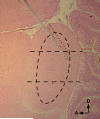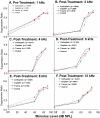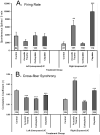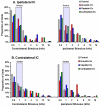Tinnitus and inferior colliculus activity in chinchillas related to three distinct patterns of cochlear trauma
- PMID: 18438941
- PMCID: PMC2614665
- DOI: 10.1002/jnr.21699
Tinnitus and inferior colliculus activity in chinchillas related to three distinct patterns of cochlear trauma
Abstract
A longstanding hypothesis is that tinnitus, the perception of sound without an external acoustic source, is triggered by a distinctive pattern of cochlear hair cell (HC) damage and that this subsequently leads to altered neural activity in the central auditory pathway. This hypothesis was tested by assessing behavioral evidence of tinnitus and spontaneous neural activity in the inferior colliculus (IC) after unilateral cochlear trauma. Chinchillas were assigned to four cochlear treatment groups. Each treatment produced a distinctive pattern of HC damage, as follows: acoustic exposure (AEx): sparse low-frequency inner hair cell (IHC) and outer hair cell (OHC) loss; round window cisplatin (CisEx): pronounced OHC loss mixed with some IHC loss; round window carboplatin (CarbEx): pronounced IHC loss without OHC loss; control: no loss. Compared with controls, all experimental groups displayed significant and similar psychophysical evidence of tinnitus with features resembling a 1-kHz tone. Contralateral IC spontaneous activity was elevated in the AEx and CisEx groups, which showed increased spiking and increased cross-fiber synchrony. A multidimensional analysis identified a subpopulation of neurons more prevalent in animals with tinnitus. These units were characterized by high bursting, low ISI variance, and within-burst peak spiking of approximately 1,000/sec. It was concluded that cochlear trauma in general, rather than its specific features, leads to multiple changes in central activity that underpin tinnitus. Particularly affected was a subpopulation ensemble of IC neurons with the described unique triad of features.
Figures










References
-
- Alkhatib A, Biebel UW, Smolders JW. Reduction of inhibition in the inferior colliculus after inner hair cell loss. Neuroreport. 2006;17(14):1493–1497. - PubMed
-
- Atherley GRC, Hempstock TI, Noble WG. Study of tinnitus induced temporarily by noise. J Acoustical Soc Amer. 1968;44(6):1503–1506. - PubMed
-
- Bauer CA, Brozoski TJ. Cochlear structure and function after round window application of ototoxins. Hear Res. 2005;201(12):121–131. - PubMed
-
- Bohne BA. Location of small cochlear lesions by phase contrast microscopy prior to thin sectioning. Laryngoscope. 1972;82(1):1–16. - PubMed
Publication types
MeSH terms
Substances
Grants and funding
LinkOut - more resources
Full Text Sources
Other Literature Sources
Medical

